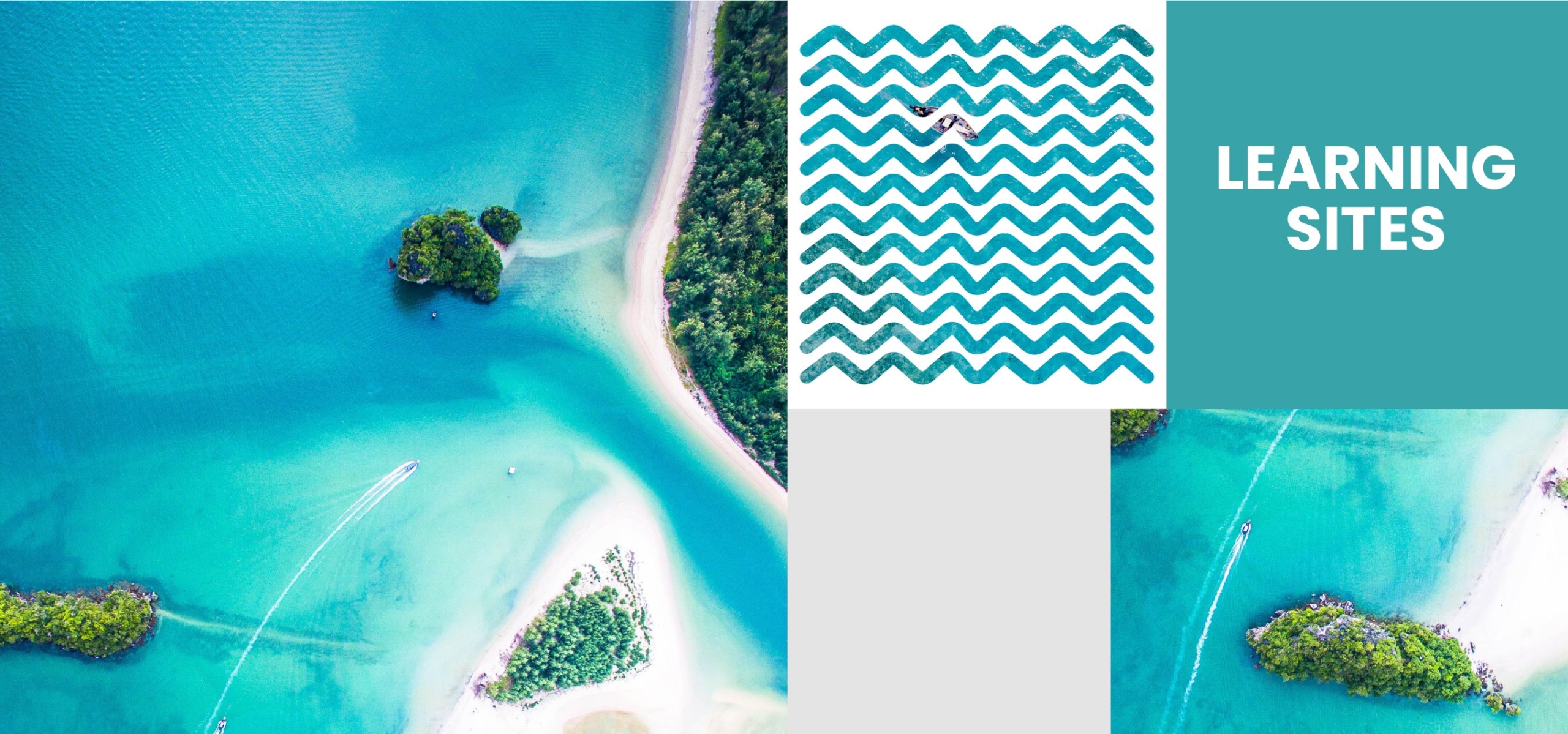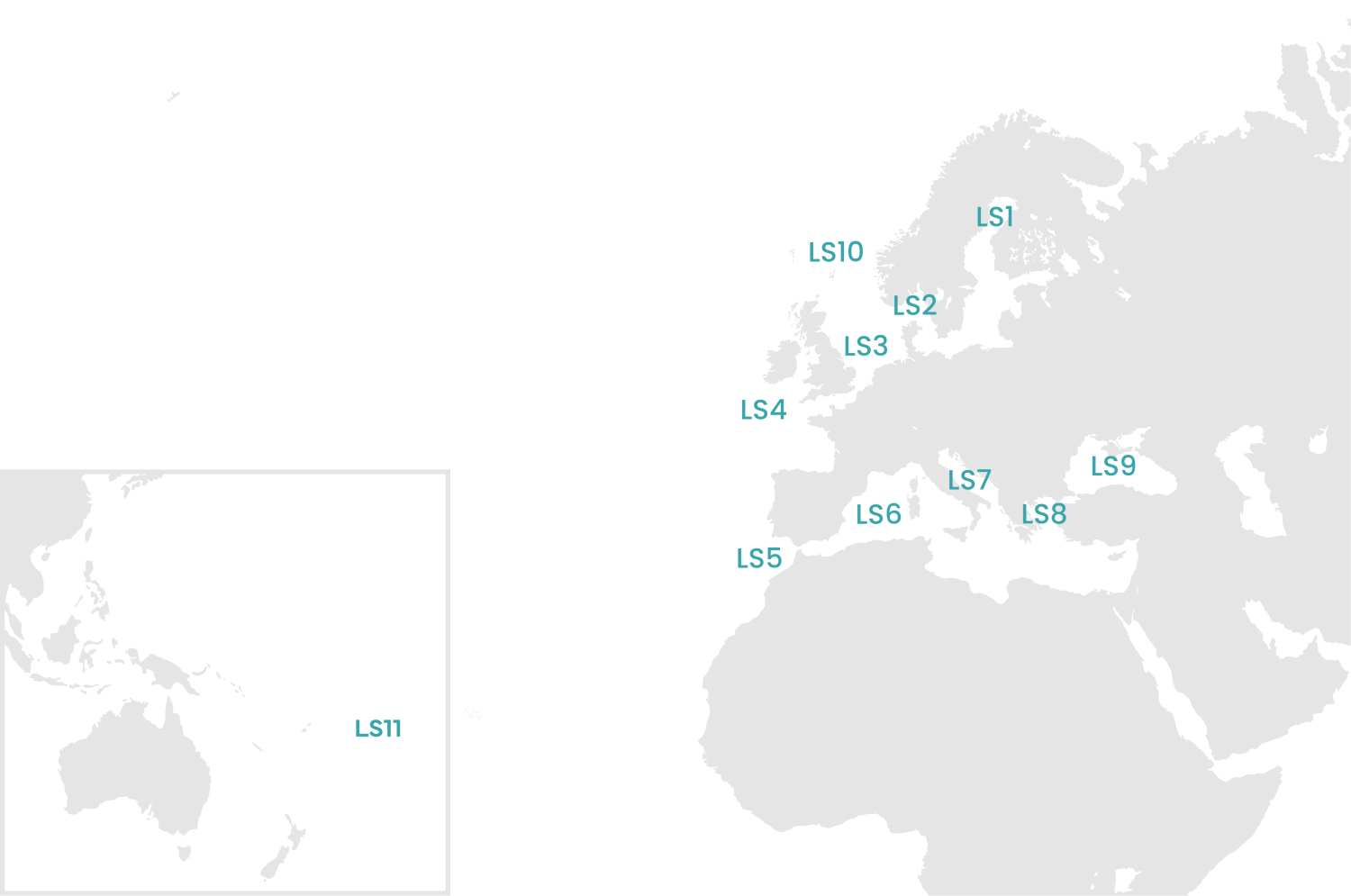LEARNING SITES
GES4SEAS will test and validate the toolbox in different Learning Sites (LSs).
LS1: Baltic Sea (Gulf of Bothnia)
This local LS is a pioneer in the use of innovative tools for the implementation of the MSFD. It is a data rich area, in which major advances in the assessment of cumulative pressures impacts and environmental status assessment have already been made.
LS2: Baltic-Atlantic (Kattegat)
It holds large data series (>50 years), first with focus on eutrophication, later other multiple pressures, having experienced change in ecosystem function. All organism levels and environmental conditions are monitored regularly. Activities have been managed intensively over decades, with a warming trend above average.
LS3: Atlantic (North Sea – Netherlands)
This small-scale LS has been exposed to intense and multiple uses, and research has accompanied this evolution. Therefore, it provides a good site to carry out a comprehensive analysis including all sectoral activities, all MSFD pressures, all major ecosystem components, and the capacity to supply many services.
LS4: Atlantic (Celtic Sea)
It is an open sea environment, supporting multiple conflicting activities (fishing, shipping, recreation and terrestrial runoff), with several pressures e.g. removal of species and seabed impacts. It has huge potential for new Blue Economy activities (offshore renewable energies and aquaculture), evaluating the risks to the ecosystem and its capacity for new activities and associated pressures, considering projected climate change scenarios.
LS5: Deep Atlantic – Mediterranean transition
It has a great diversity of deep-sea habitats from approximately 500-5000 m depth (mud volcanos to cold water corals), which are amongst the least addressed habitats under MSFD assessments. This LS extends over the Atlantic-Mediterranean corridor, which is highly relevant for the connectivity of many groups of organisms (including marine mammals, large pelagics and small pelagic fish). Proposed as an MPA by Portugal, contiguous to a Spanish Natura2000 area.
LS6: Western Mediterranean
This sub-regional scale LS includes EU and non-EU countries, and is strategically positioned, being part of one of the principal maritime corridors in the world and the gateway to Africa for European countries. It has been exposed to long-term and intense maritime and land-based human activities, which implies many pressures causing large impacts in marine ecosystems and resources.
LS7: Adriatic Sea
This sub-regional LS is one of the most impacted marine ecosystems of the Mediterranean, due to the long-term co-occurrence of multiple human activities. It has been used in several MSFD-related projects, providing a good basis for understanding any change observed when applying the GES4SEAS toolbox.
LS8: Aegean Sea
This sub-regional LS is a transboundary area between EU and non-EU countries, enabling the exploration of how different governance systems may affect the assessment of cumulative pressures. Although, long-time series of some indicators are lacking, it will benefit from the knowledge and data compiled by recent and ongoing projects to test the GES4SEAS toolbox.
LS9: Black Sea
The high residence time in the Black Sea intensifies the effects of cumulative pressures. The management of the impacts depends on cooperation and coordination between EU and non-EU countries, as they respond to different policy frameworks. Thus, the Black Sea RSC plays a major role, contributing to the LS.
LS10: Whole Europe’s Seas
Based on the other LSs, other case studies and, in particular, EEA information, with local to sub-regional scales, this LS will allow upscaling results, ensuring comparability across seas. Best practices under other LSs will be included to the GES4SEAS toolbox development.
LS11: French Polynesia
This LS is made up of 118 islands in the middle of the South Pacific Ocean, sheltering 15,000 km2 of coral reef ecosystems and lagoons. Even being distant from continents by thousands of kilometers, these islands are subject to various pressures coming from local activities and are exacerbated by climate change. Human societies heavily rely on the capacity of coral reef ecosystems to support nutritional subsistence like reef-based fishing, tourism-based economy and cultural identity. Long-term monitoring of coral reefs and decades of research on its socio-ecological context will provide the opportunity to transfer knowledge across ocean basins, under different management frameworks but towards common objectives.
LS1: Baltic Sea (Gulf of Bothnia)
This local LS is a pioneer in the use of innovative tools for the implementation of the MSFD. It is a data rich area, in which major advances in the assessment of cumulative pressures impacts and environmental status assessment have already been made.
LS2: Baltic-Atlantic (Kattegat)
It holds large data series (>50 years), first with focus on eutrophication, later other multiple pressures, having experienced change in ecosystem function. All organism levels and environmental conditions are monitored regularly. Activities have been managed intensively over decades, with a warming trend above average.
LS3: Atlantic (North Sea - Netherlands)
This small-scale LS has been exposed to intense and multiple uses, and research has accompanied this evolution. Therefore, it provides a good site to carry out a comprehensive analysis including all sectoral activities, all MSFD pressures, all major ecosystem components, and the capacity to supply many services.
LS4: Atlantic (Celtic Sea)
It is an open sea environment, supporting multiple conflicting activities (fishing, shipping, recreation and terrestrial runoff), with several pressures e.g. removal of species and seabed impacts. It has huge potential for new Blue Economy activities (offshore renewable energies and aquaculture), evaluating the risks to the ecosystem and its capacity for new activities and associated pressures, considering projected climate change scenarios.
LS5: Deep Atlantic - Mediterranean transition
It has a great diversity of deep-sea habitats from approximately 500-5000 m depth (mud volcanos to cold water corals), which are amongst the least addressed habitats under MSFD assessments. This LS extends over the Atlantic-Mediterranean corridor, which is highly relevant for the connectivity of many groups of organisms (including marine mammals, large pelagics and small pelagic fish). Proposed as an MPA by Portugal, contiguous to a Spanish Natura2000 area.
LS6: Western Mediterranean
This sub-regional scale LS includes EU and non-EU countries, and is strategically positioned, being part of one of the principal maritime corridors in the world and the gateway to Africa for European countries. It has been exposed to long-term and intense maritime and land-based human activities, which implies many pressures causing large impacts in marine ecosystems and resources.
LS7: Adriatic Sea
This sub-regional LS is one of the most impacted marine ecosystems of the Mediterranean, due to the long-term co-occurrence of multiple human activities. It has been used in several MSFD-related projects, providing a good basis for understanding any change observed when applying the GES4SEAS toolbox.
LS8: Aegean Sea
This sub-regional LS is a transboundary area between EU and non-EU countries, enabling the exploration of how different governance systems may affect the assessment of cumulative pressures. Although, long-time series of some indicators are lacking, it will benefit from the knowledge and data compiled by recent and ongoing projects to test the GES4SEAS toolbox.
LS9: Black Sea
The high residence time in the Black Sea intensifies the effects of cumulative pressures. The management of the impacts depends on cooperation and coordination between EU and non-EU countries, as they respond to different policy frameworks. Thus, the Black Sea RSC plays a major role, contributing to the LS.
LS10: Whole Europe’s Seas
Based on the other LSs, other case studies and, in particular, EEA information, with local to sub-regional scales, this LS will allow upscaling results, ensuring comparability across seas. Best practices under other LSs will be included to the GES4SEAS toolbox development.
LS11: French Polynesia
This LS is made up of 118 islands in the middle of the South Pacific Ocean, sheltering 15,000 km2 of coral reef ecosystems and lagoons. Even being distant from continents by thousands of kilometers, these islands are subject to various pressures coming from local activities and are exacerbated by climate change. Human societies heavily rely on the capacity of coral reef ecosystems to support nutritional subsistence like reef-based fishing, tourism-based economy and cultural identity. Long-term monitoring of coral reefs and decades of research on its socio-ecological context will provide the opportunity to transfer knowledge across ocean basins, under different management frameworks but towards common objectives.



